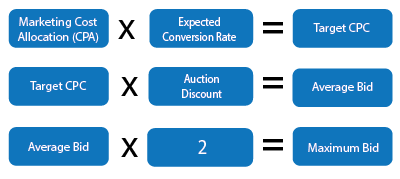In AdWords it’s all about your CPA (Cost Per Action or Acquisition) so let’s walk through this important aspect of your account. Calculating your target CPA starts with an action of value to the business. Normally this is an order, lead, or other action that the business has decided has a specific value. In this article I will walk through the stages of getting to this number and ultimately using that to create a bidding strategy CPC (Cost Per Click) target. This is a simple set of steps that anyone with a calculator can easily use.
I am going to use an e-commerce account to facilitate this discussion but it can be applied to any kind of business. To walk a client through this I ask a series of questions, stated below with a discussion of each step.
- What is the gross of an average transaction?In e-commerce this is the average order. In our example we are going to start with an order of $150. If the business is currently operating, this should be as simple as taking last month’s sales and dividing that by the total number of invoices. Most business owners know this number instantly because it is critical to their existence.
- What is the gross profit of the average transaction?Again, a simple question for a business owner and I have never had anyone that needed to look this up because again it is a critical number in the business. This can be expressed as either a dollar amount or a percentage. For our example it is 50%, which equates to $75.
- How much of the gross profit would you spend to create the transaction?We call this the marketing cost allocation and it is the one that causes everyone to stop and think. The first answer you get from many is that they want their cost to be zero or some other ridiculously low number. It is at this point that we have to stress that the higher they make this number the higher the volume of orders will be. This tends to bring the conversation back to earth, but make no mistake, this is an important and difficult discussion. On one side of the decision is what you want to pay and on the other is what your competitors will let you get away with.
Helping the business find the best balance for this decision sets the stage for success or failure of the account. What has to be stressed here with the client is that while keeping costs down is important you can in fact “save yourself out of business.” To move the conversation let’s give the process an answer of half of the profits ($75/2 = $37.50 = CPA).
Trust me when I tell you that this is one of the tough parts of this process because there is no perfect answer and it is a balance between cost and volume.
- What is the expected conversion rate? The simple way to say this is if we drive 100 people to the website how many orders do you expect to get? If the business is up and running then this is actually simple to get to. Look at your total number of orders and divide that by the total number of visitors. In most cases this is best done with traffic that is similar to the traffic you are buying. In most cases this includes the organic and paid traffic but not the direct and referral.
If you have a large spread between paid and organic then some discussion is needed to understand why they are different. If you do not have real data to work with then you have to be very careful with how you estimate this. Many people that have never worked with internet traffic are often overly optimistic. You may want 50% of the people that visit your site to purchase your product but the reality is typically much lower than that. In a typical e-commerce site a reasonable range is from 1%-5%. For this example we are going to set the expected conversion rate at 2.5%.
The calculated target CPA to CPC
Question 3 ($37.50) multiplied by Question 4 (2.5%) which gives us in this example $0.93 to get to the bid we have to add one additional item and that is the auction discount. This is the difference between your bid and your actual cost. If you bid $2.00 you will end up paying something less than $2.00 because in AdWords you are paying one penny more than the competitor behind you.
There is actually another part of the formula in that it considered your quality score. So the one penny more statement is accurate only if the competitor has the same quality score as your account. If you do not have real data to get this from then a good estimate is about 20%. To get this from your real data extract your keyword data for the last 30 days and extend the clicks by the bid and compare that to the average CPC.
Calculate the maximum bid guidance.
To guide the bidding to a target of $0.93 we have an average bid of $1.12 but like any average you have to have half your volume above and below this point. In most cases we put this somewhere in the range of about 2x that of the calculated bid. In this case that comes to $2.24 which I rounded to $2.25.
Next comes the hard part which is applying this strategy and getting the numbers to come out at your targets. When you apply this to your account you will quickly discover if your targets and assumptions are realistic.


